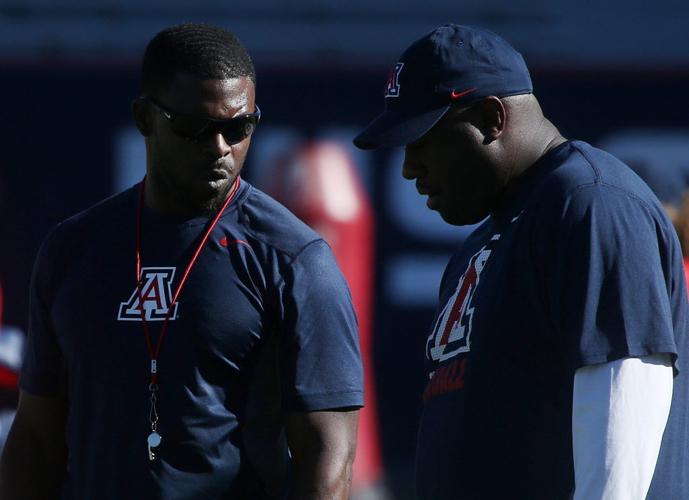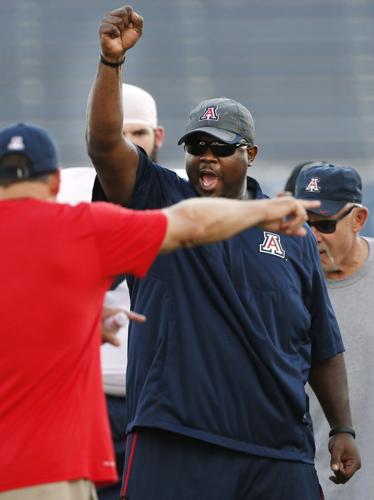Jahmile Addae and Vince Amey spent the last couple of years as coaches who, really, weren’t even allowed to coach. At least not on the field.
Both were analysts, the latest trend in a sport where programs are always looking for an edge. Some schools employ as many as 10 off-field full-time staffers in addition to the maximum nine on-field coaching positions allowed by the NCAA.
Some programs call these staffers analysts, while others are quality-control assistants. Their jobs are the same: helping with preparation and recruiting.
“Guys are taking that job because they want to be a full-time coach or be full-time off field staff,” UA coach Rich Rodriguez said. “It is what everybody was before, a traditional GA (graduate assistant), you have got those guys who want to move up and you have got analysts.”
Rodriguez had four on his staff a year ago. He ranks them above graduate assistants but below full-time coaches. Arizona is, by national standards, taking it easy. Stanford employs eight off-field aides — labeled simply offensive and defensive assistants — while Oregon State has six “quality control” coaches and ASU has one “senior defensive analyst.”
There’s no limit to how many a school can employ. The 420-page NCAA rulebook doesn’t even mention staff analysts or quality control coaches.
The jobs are “a good thing, I think,” Rodriguez said. “That creates more opportunity for more guys, whether it is a new guy coming up or a high school guy coming to college.”
Addae and Amey fell into both categories, and Addae might have been a little bit overqualified for his position.
Addae spent two years as Cincinnati’s running backs coach. Before that, Addae spent time as a graduate assistant for Rodriguez at both Michigan and West Virginia. He joined the UA staff in 2013 and held an operations coordinator role for two years.
Last year, Addae’s role was re-named “staff analyst.” Now, he’s the Wildcats’ safeties coach. Rodriguez promoted Addae in December when he fired David Lockwood.
“It was more of the grunt work, a little bit above maybe a graduate assistant,” Addae said. “You’re doing the breakdowns, weekly breakdowns, game planning for the opposition, just really helping out with any kind of office duties put upon me by our defensive coordinator and at the time our DB coach, Coach Lockwood.
“It was good because it allowed me to learn the details that maybe I had passed at other points in my career, so it was actually really helpful.”
Amey took a longer path to his first full-time college coaching job.
Amey played defensive end at Arizona State, was drafted in the seventh round by the Oakland Raiders in 1998 and then spent some time in NFL Europe and the Arena League before beginning a coaching career at the high school level.
Amey coached the defensive line at Scottsdale Chaparral before joining Arizona’s staff as a strength and conditioning coach. In 2015, he moved into a staff analyst role.
He was named the UA’s new defensive line coach last week. At 41, Amey is the oldest of Arizona’s new assistant coach hires.
“There were some bumps in the road,” Amey said. “I worked in the weight room, took a pay cut to go upstairs. … I learned a lot (as an analyst). I respect them for giving me the opportunity to sit in on the meetings and just observe and sometimes be able to, when the time is right, be able to talk to the kids about what I know and what I’ve been through.”
The Wildcats won’t technically replace Addae and Amey as analysts. Chris Singletary, formerly of Michigan, has been hired as recruiting coordinator, filling the position that came open when Addae was promoted.
The UA still employs two analysts.
One is Dusty Rutledge, who was on Rodriguez’s staff at Michigan and West Virginia. He was hired in 2015 to be in charge of practice tempo.
The other is Miguel Reveles, who coached at the high school level in California. His job description says that he “assists with the day-to-day duties of program management with a focus on special teams film breakdown.”
Reveles was allowed to recruit while Rodriguez searched to fill his staff last month. He hit the road, and helped the Wildcats reel in four-star safety Chacho Ulloa from Corona, California.
“The analysts know we’re recruiting, we have recruitment meetings, and they know who we’re recruiting, and so they did a really good job,” Rodriguez said. “Those off-field positions have become more important because of recruiting more than anything else.”
Amey and Addae are two examples of what these analyst roles can do for an up-and-coming coach’s career. Both managed to get ahead without ever coaching on the field.
“We’ve been talking about it,” Amey said. “I’ve sat in (Addae’s) office many nights and we sit there and break down film and talk about recruiting and thinking, ‘How cool would it be if we were on the road recruiting?’ And thinking, ‘it’ll happen one day.’
“Now it’s happening. We’re here, and we’re just ready to roll.”





